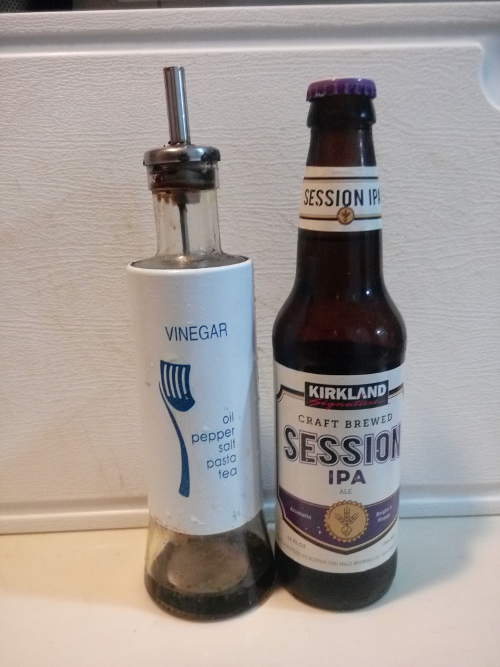Vinegar tasting beer. It’s happened to 99% of all home brewers, you open a bottle of your newly brewed beer (after waiting for it to develop in the bottle) and you get whacked in the tongue with a horrible taste. Vile vinegar!
So, why does your home-brewed beer taste like vinegar?
The culprit is a bacteria known as acetobacter or Acetic Acid Bacteria. If developed in the brewing process it will lead to the production of organic acids and a vinegary taste. This is sometimes desired in the production of sour beers such as Lambic.
How does a beer develop a vinegar taste?

The acetobacter needs oxygen to do what it does best, produce acetic acid (that vinegar taste in your mouth right now). The most likely period of the brewing process when you could be exposed to acetobacter is during a transfer. Either when transferring your beer into your fermentor or, if still not fully fermented, when bottling or casking your wort. Limiting the exposure of your brew to the air in these stages is very important. However, you can’t work in a completely air-free environment, so just try your best.
Acetobacter not only needs oxygen, it also needs food. The ethanol in your beer, unfortunately, is just what it likes. So, this bacteria effectively transforms the alcohol you were hoping for in the beer into unwanted vinegar (acetic acid). If you were to leave the bacteria to it, after several months you’d have a batch of pretty much pure vinegar on your hands.
Nevertheless, simply exposing your beer brew to the air won’t introduce acetobacter into the mix. Often poor sanitization of your equipment can be the cause of a vinegar tasting beer. Clean is the name of the game when it comes to home brewing. Always use something such as Star San or iodophor for best results (Amazon links).
If you have a secondary yeast introduced into your wort from a previous batch this can have disastrous results, including that vinegar taste. Also, this bacteria can get in from contamination from compromised equipment. Anything that comes into contact with your wort is a possible carrier of some undesired bacteria.
Cleaning your equipment thoroughly before and after use is essential. Also, consider your own interaction with the brew. Wearing latex gloves and scrubbing your surfaces isn’t necessarily a step too far. Not everyone will want to take such an extreme step, and that’s absolutely fine.
Make sure that, if using them, your bottle caps and bottle capper are as clean as you can get them as it’s impossible to rack and bottle your beer in a total air vacuum, therefore acetobacter could still be introduced at this late stage.
Also, consider the environment you are working in. Fruit flies are, for example, a notorious carrier of acetobacter. If you have fruit that is on the turn either eat it or throw it out way before you start a new homebrew. If you see these little pests in your brewing area, consider postponing your next batch and be prepared to lose your current beer baby.
Can you fix the beer and remove the vinegar taste?
If you are already into the bottling process or are cracking open that first beer of the batch, it’s probably too late to reverse a vinegar taste in your brew. It may be best to resign yourself to the fact that this beer is going down the plug hole.
However, don’t forget that that very same bacteria is used in the production of certain sour tasting beers such as lambics and German Gose beers. If you catch the problem fairly quickly after bottling your beer there is still an opportunity to get an unexpected sour beer out of it. This really depends on the recipe of the beer you have and will have to be discussed in another article.
Generally, though, this is beyond the skill of a new brewer and may not be to everyone personal taste.
The real issue here is that even if you could identify the bacteria from the appearance of your wort during the brewing process, it probably won’t help you. Because acetobacter feeds on the ethanol content of your beer its presence effectively ruins your batch. Cut your loses and learn from the mistake. Keep everything clean and minimize the exposure of your home-brew to oxygen next time.
What to do to stop a bad taste in your next home brew batch?
As we have seen, cleanliness is very important in making beer. As an organic process, the introduction of any sort of contaminant can be disastrous for a home-brew
If you are in the position to do so, consider replacing most of your equipment, especially your fermenting container and any equipment involved in the transfer of the wort.
Failing that, invest in some non-rinse sanitizing solutions specially developed for this type of process. There are several options on the market and you can get a good solution for under $30.
Also, consider brewing in as clean of an environment as you can. Keep all window closed especially during the periods of the brewing process when the beer is cool or cooling. Fermentation is also an important time to minimize the introduction of any contaminates.
Can you use that ruined beer for anything else?
Although the beer tastes a little off, it doesn’t mean it really has to end up in the sewer. Consider using that particular batch in cooking. Try a beer batter fish recipe, after all, us Brits put vinegar on our chips (french fries) so why not put it in your fish batter?
(Check out my article on 26 uses of stale beer for more ideas on what to do).
If you really don’t want to swallow this beer, you can use it to solve some common problems. Old beer is an excellent fertilizer for your lawn. Make sure that the yeast isn’t still alive, however, as this can be quite bad for the grass. You can kill off any remaining yeast by leaving the mix in a transparent container in direct sunlight over 2 to 3 days Do a little test on a patch of grass first and if all goes well, dump the rest all over your lawn.
As well as humans, slugs and snail are big lovers of the beverage of the gods ( I mean beer of course). You can use that vinegar beer in slug traps to keep them off your prized plants.
Failing that you can donate that beer to any freeloader you may happen to know. Free beer is free beer and most people will drink anything they don’t have to pay for. Find some young adults (I’m definitely not talking about minors here guys and girls) and make their day.
If you still can’t think of what to do with it, you could just drink it yourself. Let’s face it, if you are really tying one on at a party or BBQ, you can’t taste much after beer 4 or 5 anyway. At any rate, it will probably stop you from having too many more when you know you should stop anyway.
Related Questions
Can you taste beer before bottling?
Of course, you can sneak a little taste before lovingly placing your beer into bottles and adding your priming sugars. However, be aware that your beer will be extremely flat here as carbonation hasn’t occurred yet. The best thing is to take a hydrometer sample and taste your beer throughout each stage of the process. (See my article on how to use a hydrometer properly). Do, however, try not to expose your beer to the air too much before sealing it tightly in the bottles. Bad things could happen if you do.
What are some other off-flavour tastes in beer?
Beer can have many flavors during its natural fermentation and brewing process. Some are more desirable than others and can add or take away from the drinking experience.
Following are some of the off-flavours or smells you may experience in your time as a homebrewer: butter, sweetcorn, metallic, sulfur or rotten eggs, banana, rotten vegetables, skunky, goat cheese, baby vomit, wheaty, sour milk, cat (who’s tasting cat?) to name but a few.




